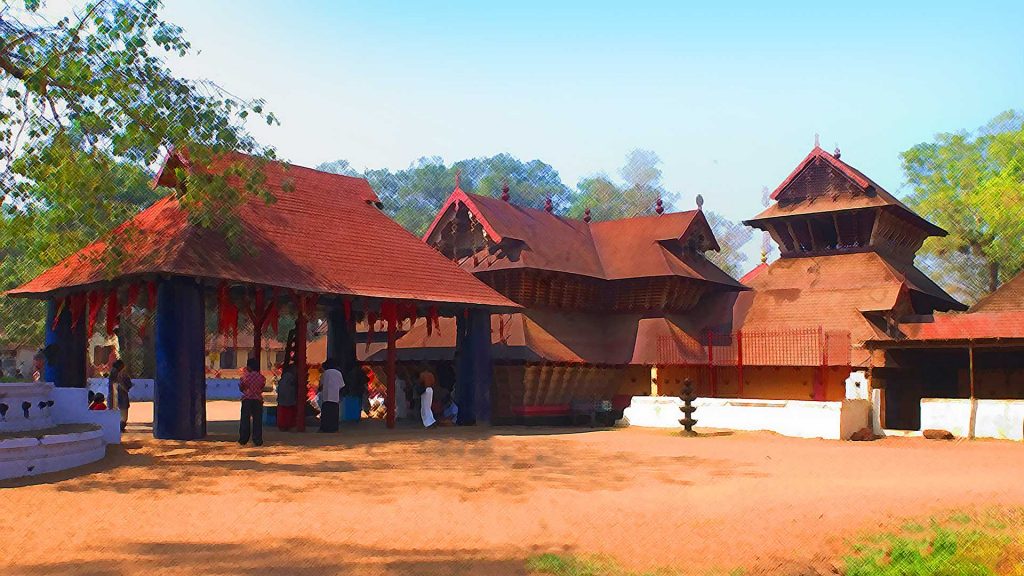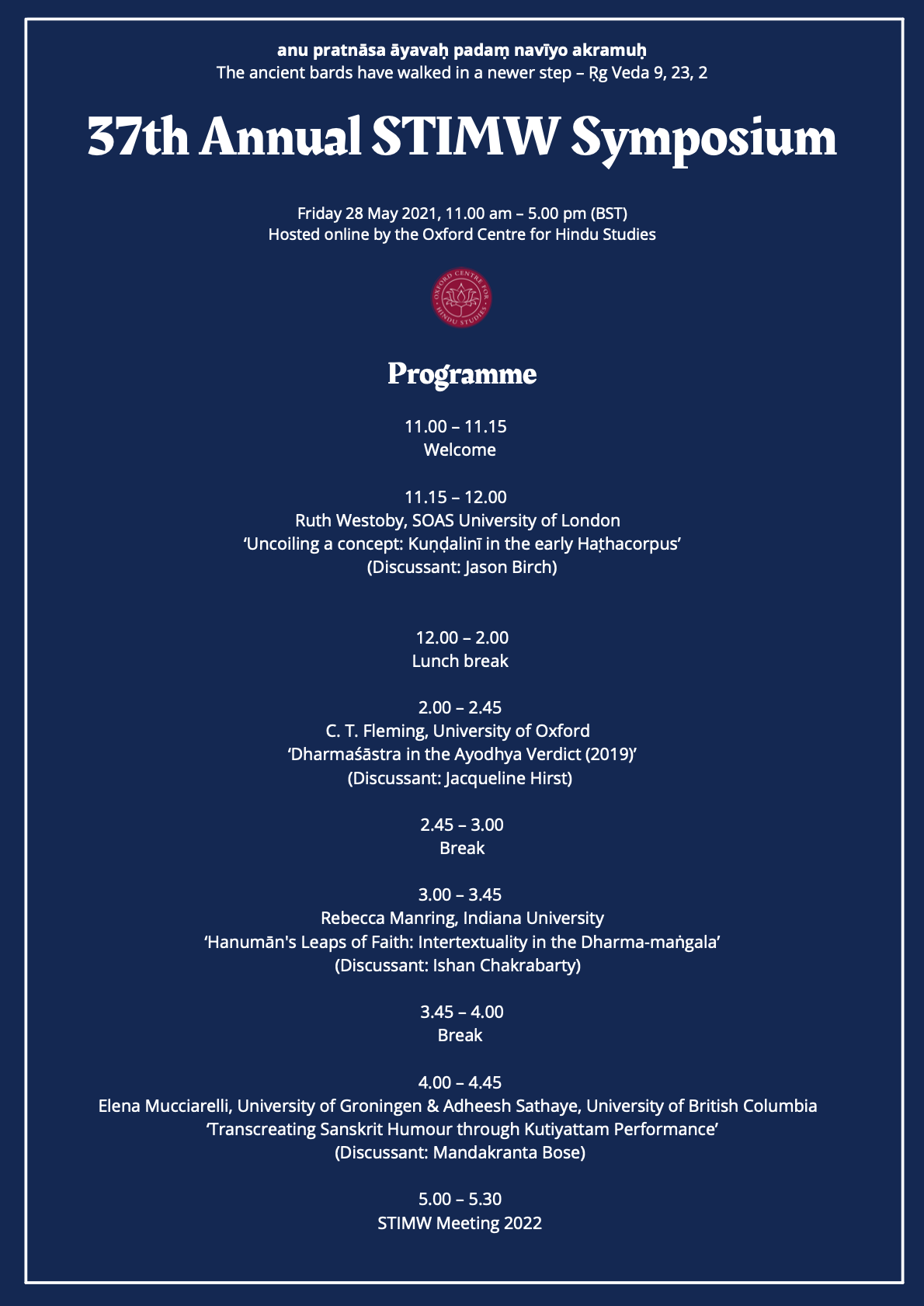THE BHĀṆA PROJECT
What does it mean to translate classical Sanskrit humour? That is, how best can we capture the contextualized meanings and motivations behind the production of various modes of hāsya within the conventions of Sanskrit theatre? This project offers new answers to these questions by paying special attention to the function of live enactment, or performance. We work with traditional performers of Sanskrit theatre in India to transcreate – rather than translate – Sanskrit humor into the medium of digital film. We present here an initial set of outcomes of a close collaboration in December 2020 with the Nepathya Centre for Excellence, located in Moozhikkulam, Kerala, that brings the classical Sanskrit genre of bhāṇa (comedic monologue) in dialogue with the only living tradition of Sanskrit theatre, Kūṭiyāṭṭam, in order to explore the performative nature of humor.
The first output from this project is a paper to be delivered at the 37th Annual Sanskrit Traditions in the Modern World Symposium (STIMW) convened by the Oxford Centre for Hindu Studies and to be held online on Friday May 28, 2021 (4PM BST – 8AM PST). Interested readers may download the pre-publication of the paper at the address above, or register free for the Zoom meeting via the STIMW Eventbrite link.
THE RASASADANA BHĀṆA
GODAVARMA YUVARAJA
The Rasasadana (“House of Love”) Bhāṇa of Godavarma Yuvaraja (1800-1851) is one of the more notable examples of the Sanskrit bhāṇas of Kerala. Godavarma belonged to the royal family of Koṭuṅṅallūr (Kodungallur), a family who was, as Kamala Kumari (1993: 8) has noted, “well-known for its encouragement and propagation of Sanskrit education in Kerala.” He was a prolific poet and scholar, who wrote at least seventeen poetic and theoretical works in Sanskrit, as well as a number of others in Malayalam. He is regarded as a founder of the Veṇmaṇi School of Malayalam literature, noted for its adoption of a “pure” Malayalam register and focus on realism and naturalism (Ramachandran Nair 1999: 851). The Rasasadana, though written in Sanskrit and structured as a normative work of classical Sanskrit theatre, reflects both this localized environment of Kodungallur and the local cultural sphere of Kerala performing arts.

THE PLOT OF THE RASASADANA
The Rasasadana-bhāṇa opens as an actress (naṭī) joins the director (sūtradhāra) on stage to give benedictions and introduce the premise of the play. For the rest of the show, only one character is physically present throughout the play, the Viṭa (“playboy”) named Pallavaka. He is clever, confident, and married; an expert in the erotic arts and wise to the ins and outs of the red-light district. His friend has asked him to escort his wife, Candanamālā, to go and worship at the temple of the Goddess Bhadrakālī (Bhagavathy) amidst the annual Keliyātrā (Tālappoli) festival that is happening at the temple. During the morning hours, the Viṭa successfully accomplishes this task, with an assortment of encounters along the way. In the evening hours, the Viṭa again visits the temple area, where he meets and interacts with a variety of courtesans and experiences a number of various local evening shows that are taking place at the festival – singers, dancers, circus acrobats, sword jugglers, magicians, and theatre performers. His day ends with a return to his friend’s home, where he engages in witty banter with his friend and his wife.
KERALA SANSKRIT THEATRE
KŪṬIYĀṬṬAM
Kūṭiyāṭṭam is the only surviving tradition of the live performance of Sanskrit drama. It has a history of more than thousand years. In earlier centuries, this art form was exclusively performed in Hindu temples of Kerala, in South India. A performance space, known as kūtambalam, would be built in Kerala temples especially for Kūṭiyāṭṭam and related art forms. At that time, Cākyār and Nambyār families alone were doing this art form as a part of their traditional ritual. During the last 50 years this art form has come out of the temples and the training has shifted from the traditional families to academies that are open to any interested students. In 2001, UNESCO deemed Kūṭiyāṭṭam to be a Masterpiece of the Oral and Intangible Cultural Heritage of Humanity.
CĀKYĀR KŪTTU
A genre of comedy known as the Cākyār Kūttu occupies a special place within the performance tradition of Kūṭiyāṭṭam. In this art form, the stage is occupied by a single actor (cākyār) whose main mode of expression is discourse. This male performer is accompanied on stage by a solo drummer, as he recites Sanskrit verses taken from a vast narrative repertoire (prabandha), and offers commentary, glosses and expansions in Malayalam. As he explains the Sanskrit text to vernacular audiences, the Cākyār Kūttu performer often will address realworld political and social issues that are relevant to the audience and thereby transcend the story. This realworld referentiality is introduced through a sophisticated production of irony. We seek to reconcile these localized Kerala inflections of humour with the broader rasa-based understandings of hāsya that have been theorized in classical (mārga) Sanskrit aesthetics.
NEPATHYA CENTRE FOR EXCELLENCE IN KŪṬIYĀṬṬAM
The Nepathya Centre for Excellence in Kūṭiyāṭṭam, located in the village of Moozhikkulam in Kerala, has been active in producing theatrical performances and training students since 1998. Guided by Margi Madhu Chakyar and Indu G., the ensemble has gained international acclaim with tours and performances across Canada, the United States, Europe, Asia, and the Middle East. In July 2018, Nepathya offered a Gala Performance of Kutiyattam Sanskrit Theatre at the 17th World Sanskrit Conference in Vancouver, hosted by UBC.
Featured in the video sample is Margi Madhu Chakyar as the viṭa (the libertine), with accompaniment by two miḻāvu drummers, Nepathya Jinesh and Kalamandalam Manikandan, and the iḍakka artist, Kalanilayam Rajan, as well as cymbals by Indu G.
SAMPLE TRANSLATION OF THE RASASADANA BHĀṆA
॥ नान्दी ॥
प्रयते केरलदेशे प्रथितं
राराष्टि कोटिलिङ्गपुरम् ।
श्रीमान्युवराजाख्यस्तत्रास्ते
दीर्घदर्शिमुकुटमणिः ॥ १ ॥
[Benedictions]
- In the pure country of Kerala, the celebrated town of Koṭiliṅga (Kodungallur) shines bright.
There lives there a certain gentleman named Yuvarāja,
the crown jewel of insightful intellectuals.
कालीकृपाकटाक्षक्षपिताखिल-
कल्मषौघधिषणोऽयम् ।
रससदननामधेयं सुधियां
प्रीत्यै करोति भाणमिमम् ॥ २ ॥
- The flaws that had piled up in his mind – each and every one – have been eradicated through one merciful sidelong glance of Kālī.
And now this fellow has created, for the pleasure of the literati,
this monologue (bhāṇa) called the Rasasadana – The House of Rasa.
ब्रह्मेन्द्रादित्रिदशमुकुटीपद्मरागप्रकाश-
प्रातःसंध्यासमधिगमनस्मेरपादाम्बुजश्रीः ।
श्रद्धापूर्वप्रणतजनताकामसंतानवल्ली
नित्यानन्दं दिशतु भवतां नन्दिनी चन्द्रमौलेः ॥ ३ ॥

- The Goddess is beautiful
with her blossoming lotus-feet that outshine the time of the early dawn,
whose light has a lotus-red luster from the crown jewels of Brahmā, Indra, and the other Thirty Gods.
She is a vine that fulfills the wishes
of the masses who bow down before her, filled with faith.
May the Delightful Lady of Śiva, with his crescent crown,
bestow eternal bliss upon you all.
अपि च ।
Furthermore,
नित्यं नश्चित्तपद्मे परिलसतु कपाली कपालीकपाली–
मालाधारी समस्तप्रमदजनकलापः कलापः कलापः ।
भूत्वा निर्भाति यस्याधिकमसुसमरीणामरीणामरीणा-
मुत्पेष्टा यश्च दूरीकृतकमलमहस्तोमहस्तो महस्तः ॥ ४ ॥
- May Śiva play around deep in our hearts, carrying a skull (kapālī) and wearing a necklace made of heads (kapālī) and rows of hissing serpents (ka-pa-ālī).
The moon (kalā-āpa), who guards over the artistry (kalā-pa) of everyone in love,
becoming an ornament (kalāpa) on his head and beams down even more.
He’s a crusher of the enemies (ariṇāṃ) of the divine goddesses (amarīṇāṃ),
who are separated from those who as dear to them as life itself (asu-sama-rīṇā).
His hand (hasta), through its radiance (mahas-taḥ),
surpasses the fame of the beauty (maha-stoma) of the lotus.
( नान्द्यन्ते प्रविशति सूत्रधारः । )
At the end of the Nāndī, then enters the Director.
…
…
व्रीडापरश्वधविभिन्नकटाक्षकाष्ठै-
र्मन्दस्मितेन च मुखोदितमारुतेन ।
संधुक्ष्य रागदहनं यवचित्तकुण्डे
तद्धीरतामयमियं हविराजुहोति ॥ ९३ ॥
- With firewood that is her glance,
cut by an axe that is modesty,
And with a gently blown puff of wind – the words from her mouth,
this lady lights the fire of burning passion
in the sacrificial altar that is the young man,
making an offering of his resolve.
गाथां केरलभाषया विरचितां शृङ्गारहास्यादिभिः
पूर्णां पुण्यपुराणवर्णनमयीं गायन्नयं नर्तकः।
तालोज्जृम्भितमर्दलस्वनसमं नृत्यन्दृशोर्विभ्रमै-
र्भावव्यञ्जनकारिभिर्वितनुते प्रीतिं सभावासिनाम् ॥ २०० ॥
- This actor is singing a song composed in the language of Kerala, based on a story from a sacred purāṇa.
It’s filled with passion and humor and such.
He dances in sync to the sounds of the maddaḷam (mardala) drum,
that are bolstered (ujjṛmbhita) by the ilattāḷam (tāla) cymbals;
and with the striking movements of his eyes, that produce emotive expression,
he expands the delight of members of the audience.
मध्ये दीपज्वलनमधुरे पार्श्वतः पाणिधस्त्री-
चित्रीभूते सरसहृदयैर्भूसुरैर्भासुराग्रे ।
पृष्ठे मार्दङ्गिकविलसिते रङ्गदेशे प्रविष्टः
स्पष्टाकूटं नटयति नटः कोऽपि कंचित् प्रबन्धम् ॥ २२० ॥
- The stage is rocking to the beat of the drum in the back,
in the middle is a pleasant shining lamp,
while on the side there are marvelous female musicians,
and, in the front, distinguished Brahmins,
the rasa-connoisseurs.
Onto this stage, some actor enters,
and enacts some sort of story
(prabandham) with clear expressions.
अये कोऽयं दण्डपाणिरग्रतो दुःशकुनीभवति ।
Oh! Who is this man in front of me, carrying a staff and looking like a bad omen?
( विभाव्य । )
(Comprehending.)
आ ज्ञातम् ।
Oh, I know!
दुर्गन्धं दशनेषु मूर्तमिव यो धत्ते चिरात्संचितं
कृष्णश्वेतमलं मलं मलिनता पात्रं च वस्त्रं कटौ ।
जातस्वेदपरागधूसरतनुर्दूरीकृतो यौवतैः कामभ्रान्त
इतीरितो द्विजसुतः सोऽयं समागच्छति ॥ २३० ॥
- He’s got a stink in his teeth, that’s been built up for so long it’s like it’s alive,
The dirty cloth around his ass – stained black and white – is a sack of filth.
The powder he uses for his sweat has turned his body grey,
and the girls keep their distance.
They call this son-of-a-Brahmin, “Kāmabhrānta” – the sex maniac.
And that’s just who he is,
this guy coming here.
…
…
